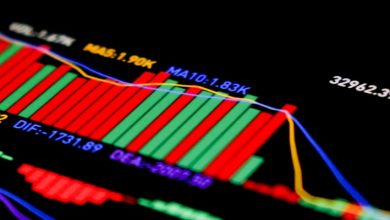How to Analyze Crypto Market Cycles

- Understanding the basics of crypto market cycles
- Identifying key indicators for analyzing market cycles
- Strategies for predicting market trends in the crypto space
- The role of investor psychology in crypto market cycles
- Tools and resources for tracking and analyzing market cycles
- Case studies of successful market cycle analysis in cryptocurrency
Understanding the basics of crypto market cycles
Understanding the fundamentals of the crypto market cycles is crucial for any investor or trader looking to navigate the volatile cryptocurrency market successfully. Crypto market cycles are characterized by periods of expansion and contraction, with prices of digital assets fluctuating based on various factors.
One key aspect to consider when analyzing crypto market cycles is the concept of bull and bear markets. Bull markets refer to periods of rising prices and overall optimism in the market, while bear markets are characterized by falling prices and pessimism among investors. Recognizing these market trends can help traders make informed decisions about when to buy or sell.
Another important factor to consider when analyzing crypto market cycles is the role of market sentiment. Market sentiment refers to the overall feeling or attitude of investors towards a particular asset or market. Positive sentiment can drive prices higher, while negative sentiment can lead to price declines.
Additionally, it is essential to pay attention to market indicators and technical analysis when studying crypto market cycles. Indicators such as moving averages, volume, and RSI can provide valuable insights into market trends and potential price movements. Technical analysis can help traders identify key support and resistance levels, as well as patterns that may indicate future price movements.
Overall, understanding the basics of crypto market cycles is essential for anyone looking to navigate the cryptocurrency market successfully. By staying informed about market trends, sentiment, and technical indicators, traders can make more informed decisions and increase their chances of success in the volatile world of cryptocurrencies.
Identifying key indicators for analyzing market cycles
When analyzing market cycles in the crypto industry, it is crucial to identify key indicators that can provide valuable insights into the current state of the market. These indicators can help traders and investors make informed decisions about when to buy or sell their assets. By paying close attention to these indicators, market participants can better understand the dynamics of the market and anticipate potential price movements.
One key indicator to consider when analyzing market cycles is trading volume. Trading volume refers to the total number of assets that are bought and sold within a specific period. High trading volume typically indicates increased market activity and interest in a particular asset, which can be a sign of a bullish market cycle. Conversely, low trading volume may suggest a lack of interest or uncertainty among traders, signaling a bearish market cycle.
Another important indicator to look at is price trends. By analyzing the historical price movements of a cryptocurrency, traders can identify patterns and trends that may indicate the direction of the market cycle. For example, an upward trend in prices over a sustained period could signal a bullish market cycle, while a downward trend may indicate a bearish market cycle.
Market sentiment is also a crucial indicator to consider when analyzing market cycles. Market sentiment refers to the overall attitude and emotions of traders and investors towards a particular asset. Positive market sentiment, such as optimism and confidence, can drive prices higher and signal a bullish market cycle. On the other hand, negative market sentiment, such as fear and uncertainty, can lead to price declines and indicate a bearish market cycle.
In addition to these key indicators, it is essential to consider external factors that can impact market cycles, such as regulatory developments, technological advancements, and macroeconomic trends. By taking a holistic approach to analyzing market cycles and considering a wide range of indicators, traders and investors can gain a more comprehensive understanding of the market and make more informed decisions.
Strategies for predicting market trends in the crypto space
There are several strategies that can be used to predict market trends in the crypto space. These strategies can help investors make informed decisions and maximize their profits. One of the most important strategies is technical analysis, which involves studying past market data to identify patterns and trends. By analyzing factors such as price movements, trading volumes, and market sentiment, investors can gain valuable insights into where the market may be headed.
Another key strategy is fundamental analysis, which involves evaluating the underlying factors that can affect the value of a cryptocurrency. This can include factors such as the technology behind the cryptocurrency, its use cases, and the team behind the project. By understanding these fundamental factors, investors can make more informed decisions about which cryptocurrencies to invest in.
Sentiment analysis is also an important strategy for predicting market trends in the crypto space. This involves analyzing social media, news articles, and other sources of information to gauge the overall sentiment around a particular cryptocurrency. By understanding how investors feel about a cryptocurrency, investors can get a sense of whether the market is bullish or bearish, and adjust their investment strategies accordingly.
Finally, keeping up to date with market news and developments is crucial for predicting market trends in the crypto space. By staying informed about regulatory changes, technological advancements, and other key developments in the industry, investors can stay ahead of the curve and make more informed investment decisions.
The role of investor psychology in crypto market cycles
Investor psychology plays a crucial role in shaping the cycles of the cryptocurrency market. The emotions and behaviors of investors can greatly influence the price movements of digital assets. During bull markets, investors may exhibit euphoria and greed, driving prices to new highs. Conversely, during bear markets, fear and panic can lead to massive sell-offs and price declines. Understanding these psychological factors can help investors navigate the volatile crypto market more effectively.
One key concept in investor psychology is the herd mentality. This phenomenon occurs when investors follow the crowd rather than making independent decisions based on research and analysis. As a result, market movements can become exaggerated, leading to unsustainable price bubbles or crashes. It is important for investors to remain rational and disciplined in their approach, rather than succumbing to FOMO (fear of missing out) or FUD (fear, uncertainty, and doubt).
Another psychological factor that influences market cycles is cognitive bias. Investors may fall victim to biases such as confirmation bias, where they seek out information that confirms their existing beliefs, or recency bias, where they focus on recent events rather than historical data. By being aware of these biases and actively seeking to mitigate them, investors can make more informed decisions and avoid costly mistakes in the crypto market.
Overall, investor psychology plays a significant role in driving the cycles of the crypto market. By understanding the emotions, behaviors, and biases that influence market participants, investors can better navigate the highs and lows of the digital asset landscape. Staying disciplined, rational, and objective in the face of market fluctuations can help investors achieve long-term success in the dynamic world of cryptocurrency trading.
Tools and resources for tracking and analyzing market cycles
There are various tools and resources available for tracking and analyzing market cycles in the crypto industry. These tools can help investors and traders stay informed about the current market trends and make more informed decisions. Some of the most commonly used tools include:
- Cryptocurrency market analysis websites: Websites like CoinMarketCap and CoinGecko provide real-time data on cryptocurrency prices, market capitalization, trading volume, and more. They also offer charts and graphs that can help users visualize market trends over time.
- Technical analysis tools: Platforms like TradingView offer a wide range of technical analysis tools that can help traders identify patterns and trends in price movements. These tools can be used to predict potential market cycles and make more accurate trading decisions.
- Sentiment analysis tools: Tools that analyze social media and news sentiment around specific cryptocurrencies can provide valuable insights into market sentiment. By tracking the overall sentiment towards a particular cryptocurrency, traders can gauge market sentiment and make more informed decisions.
Additionally, there are resources like market cycle research reports, online forums, and newsletters that can provide valuable insights into the crypto market cycles. By utilizing these tools and resources, investors can gain a better understanding of market cycles and potentially improve their trading strategies.
Case studies of successful market cycle analysis in cryptocurrency
Several successful case studies have demonstrated the effectiveness of analyzing market cycles in the cryptocurrency industry. By studying past patterns and trends, investors and traders can make more informed decisions about when to buy or sell digital assets. These case studies highlight the importance of understanding market cycles and using this knowledge to navigate the volatile crypto market.
One notable example of successful market cycle analysis in cryptocurrency is the 2017 bull run. During this period, Bitcoin and other digital currencies experienced a massive surge in value, followed by a sharp correction. Traders who accurately predicted the peak of the market cycle were able to capitalize on the opportunity and maximize their profits. By studying historical data and market indicators, these traders were able to identify key trends and make strategic trading decisions.
Another case study that showcases the benefits of market cycle analysis is the 2018 bear market. As prices plummeted and investor sentiment turned negative, traders who understood market cycles were able to protect their capital and even profit from the downturn. By recognizing the signs of an impending market reversal, these traders were able to adjust their trading strategies accordingly and avoid significant losses.
Overall, these case studies demonstrate the importance of analyzing market cycles in the cryptocurrency industry. By studying past trends and patterns, traders and investors can gain valuable insights into the market dynamics and make more informed decisions. Whether it’s identifying the peak of a bull run or navigating a bear market, understanding market cycles can be a powerful tool for success in the crypto industry.



